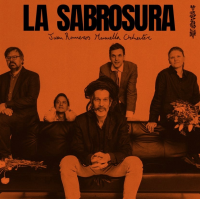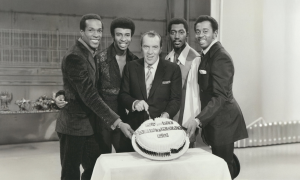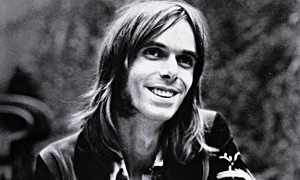Home » Jazz Articles » Film Review » The Complete Jazz Casual Series
The Complete Jazz Casual Series
 The Complete Jazz Casual Series
The Complete Jazz Casual Series Various Artists
Efor Films
2004
If Ken Burns' 10-disc "Jazz" is a freshman lecture, this is a senior recital.
All 28 episodes from America's first television jazz series are featured in the eight-DVD boxed set The Complete Jazz Casual Series, where a huge number of legendary musicians such as John Coltrane and Dizzy Gillespie displayed their prowess between 1961 to 1968. Whereas Burns' series is slick and sometimes droning, Jazz Casual is raw and immensely more enjoyable—but marred by basic production gaffes that cause extra frustration because they are so easily correctable.
Jazz instructor, columnist and Rolling Stone magazine cofounder Ralph Gleason hosted the half-hour programs for the U.S. National Education Television Network. The black-and-white shows are prototypical public television of the era—bare-bones stages, basic camera shots, mediocre audio and a stuffy overall atmosphere. But the lack of gloss is mostly a plus, as there's nothing to supply entertainment beyond the musicians who were given complete freedom to perform however they so chose—and without excessive intrusion most play superbly.
Viewers might not see B.B. King at the top of his game interacting with an adoring audience or Paul Winter playing the best solos of his career with his sextet, but there's almost never a sense any player is mailing it in. The only oddity is wondering if they failed to keep the studio cool enough—a lot of musicians are sweating. In many ways it triggers memories of David Sanborn's vastly underappreciated "Night Music" (another show in dire need of reissue), although it lacks the open jams between guest performers that highlighted the late 1980s series.
There's no way to hit all the highlights or ridicule the lesser moments in the space available here, but among the noteworthy moments: Count Basie's lighthearted improvised set, beginning with a tune he shrugs off during an interview as "I Don't Know" (by the way, he and Gleason are both smoking during their rather casual chat—all kinds of bits like this add a feeling of priceless nostalgia); Coltrane playing with near-peak fire on "Afro Blue" and "Impressions" with his legendary quartet, especially drummer Elvin Jones, contributing mightily to the intensity (and usual lack of "beauty"); and simply watching legends such as Jim Hall, Vince Guaraldi and Carman McRae performing without pretensions of celebrity at or near the height of their talent.
Among the misses: A 1963 interview with Louis Armstrong where past songs are played as historic photos are shown and he then comments, which offers a few interesting nuggets but little energy and a too-reverential approach from Gleason. Woody Herman And His Swingin' Herd are decent, but not worth three appearances—the most of any performer—which takes up an entire DVD.
Gleason keeps a generally low profile on most shows, providing a brief introduction to the players and short interviews (there's no "set" format, obviously part of the musicians determining how they want to use their time). His questions usually are basic but not banal, such as asking Sonny Rollins if he thinks about reinterpreting music he's listening to and if frequently performed pieces change structure during different performances (abbreviated answers: sort of and not really since the structures have lots of room to roam).
Sometimes it's a bit contentious, such as when he and Mel Torme get into a relatively extended discussion about whether he's a true jazz singer. Torme's overview of history and defense of himself certainly makes watching his performance more interesting—I'm not a fan, but he's convincing doing things like blues scat on "Dat Dere." Occasionally Gleason's a bit tentative and doesn't get much from the musicians, but it's much more humane and watchable than modern interviewers who fawn, attack and dominate airtime making long statements with no real questions attached.
There's a few annoying moments, such as cutaways to Gleason during some extended solos to tell us we're listening to a solo. The shows appear to be grouped arbitrarily instead of chronologically or any other apparent order, keeping viewers from observing the progression of jazz during the decade. There are also some abrupt endings as show lengths clash with musicians playing without excessive concern for time, which actually is less irritating than compromising performances.
Inexcusable, however, are the production problems. First and foremost is the lack of a continuous play option—viewers have to navigate through at least two menus for each episode, so there's no chance of inserting a disc and walking away for a couple of hours. Almost equally bad are inconsistent volume levels between episodes; the original shows no doubt had to deal with imperfect technology and the wide range of performers, but basic engineering during the remastering process would have solved it for the DVDs.
One positive production note that may not be fully appreciated unless one takes them traveling or sends them overseas as a gift is the DVDs are in both PAL and NTSC formats, and compatible with virtually any player worldwide. The 32-page handbook provides basic information about the musicians, although more explanation of what they're playing and fewer "this is a great show not to be missed" comments would be nice.
The entire set costs $150 and is only available from a limited number of sources (ejazzlines.com among them). A handful of individual shows are more widely available for those on more limited budgets or who wish to sample the shows before making a full commitment.
Even though this series is shorter and more expensive than Burns' series, it is ultimately a better value. It took a few weeks to get through Jazz, watching an hour at a time almost as a disciplined academic exercise. I blew through the entire Jazz Casual series in a day, wanting to revisit a number of moments that gave me new insights into performers familiar and unfamiliar, but also wanting to see what the next musicians were up to. It's doubtful I'll revisit much of the Burns material unless there's some historical nugget I'm seeking, but Gleason's show is likely to get occasional and steady play when the mood and/or setting seems right for keeping an eye on the legends as well as hearing them.
DVD 1:
John Coltrane Quartet (December 7, 1963):
John Coltrane (tenor saxophone); McCoy Tyner (piano); Jimmy Garrison (bass); Elvin Jones (drums).
1. Afro Blue; 2. Alabama; 3. Impressions
Sonny Rollins with Jim Hall (March 23, 1962):
Sonny Rollins (tenor saxophone); Jim Hall (guitar); Bob Cranshaw (bass); Ben Riley (drums).
1. The Bridge; 2. God Bless the Child; 3. If Ever I Would Leave You
B.B. King (May 9, 1968):
B.B. King (guitar); Mose Thomas (trumpet); Lee Gatling (tenor saxophone); James Toney (organ); Sonny Freeman (drums).
1. Please Love Me; 2. I've Got a Mind to Give Up Livin'; 3. Think I'll Move to the Jungle; 4. Darling, You Know I Love You; 5. That's Wrong, Li'l Mama
DVD 2:
Gerry Mulligan Quartet (July 18, 1962):
Gerry Mulligan (baritone saxophone); Bob Brookmeyer (tromone); Wyatt Ruther (bass); Gus Johnson (drums).
1. Four for Three; 2. Darn That Dream; 3. Open Country; 4. Utter Chaos
Art Pepper Quartet (May 9, 1964):
Art Pepper (alto saxophone); Frank Strazzeri (piano); Hersh Hamel (bass); Bill Goodwin (drums).
1. The Trip; 2. D Section; 3. Untitled
Art Farmer with Jim Hall (January 10, 1964):
Art Farmer (trumpet); Jim Hall (guitar); Steve Swallow (bass); Walter Perkins (drums).
1. Change Partners; 2. Some Time Ago; 3. My Kinda Love; 4. My Little Suede Shoes; 5. Bags' Groove
DVD 3:
Charles Lloyd Quartet (June 18, 1968):
Charles Lloyd (flute, tenor sax); Keith Jarrett (piano, soprano sax); Ron McClure (bass); Jack DeJohnette (drums)
1. Love Ship (C. Lloyd); 2. Tagore (C. Lloyd); 3. Passin' Thru (C. Lloyd); 4. Forest Flower (C. Lloyd)
Paul Winter Sextet (March 1, 1963):
Richard Whitsell (trumpet), Winter (alto sax), Jay Cameron (baritone sax), Warren Bernhardt (piano), Arthur Harper, Jr. (bass), Ben Riley (drums).
1. Bells and Horns (M. Jackson); 2. Port Au Prince Suite: Invocation To Dambala / Prayer / Pap Zimbi (W. Bernhardt); 3. Casa Camara (R. Evans); 4. The Thumper (J. Heath)
Bola Sete and Vince Guaraldi Quartet (September 25, 1963):
Bola Sete (guitar), Guaraldi (piano), Fred Marshall (bass), Jerry Granelli (drums).
1. Outra Vez (A.C. Jobim); 2. Tango El Bongo (G. Van Epps); 3. Tour De Force (D. Gillespie); 4. Star Song (Guaraldi-Siden); 5. Mambossa (Sete-Claudio)
Turk Murphy and The San Francisco Jazz Band (June 20, 1962):
Bob Neighbor (trumpet), Turk Murphy (trombone), Bob Helm (clarinet, vocal), Peter Clute (piano), Harold Johnson (tuba), Lloyd Byasse (drums)
1. 1919 Rag (Jouve-Terran); 2. Daybreak Blues (B. Helm); 3. Dr. Jazz (Oliver-Melrose); 4. Terrible Blues (C. Williams); 5. Sidewalk Blues (Morton-Melrose); 6. The Weary Blues (Cates-Greene- Mathews)
DVD 4:
Woody Herman—Program I (Summer 1963):
Bill Chase, Dave Gale, Billy Hunt (trumpets); Phil Wilson, Henry Southall, Bob Rudolph (trombones); Woody Herman (clarinet); Sal Nistico, Jackie Stevens, Bobby Jones (tenor saxophones); Frank Hittner (baritone saxophone); Nat Pierce (piano); Chuck Andrus (bass); Jake Hanna (drums).
1. Molasses; 2. El Toro Grande; 3. Lonesome Old Town; 4. That's Where It Is; 5. Cousins
Program II (June 1, 1963):
Bill Chase, Paul Fontaine, Dave Gale, Gerry Lamy, Billy Hunt (trumpets); Phil Wilson, Henry Southall, Bob Rudolph (trombones); Woody Herman (clarinet); Sal Nistico, Jackie Stevens, Bobby Jones (tenor saxophones); Frank Hittner (baritone saxophone); Nat Pierce (piano); Chuck Andrus (bass); Jake Hanna (drums).
1. Taste of Honey; 2. My Wish; 3. Deep Purple; 4. Early Autumn; 5. Satin Doll; 6. Mood Indigo; 7. Blue Flame
Program III (February 15, 1964):
Bill Chase, Paul Fontaine, Dabby Nolan, Gerry Lamy, Billy Hunt (trumpets); Phil Wilson, Henry Southall, Kenny Wexsel (trombones); Woody Herman (clarinet); Sal Nistico, Carmen Leggio, Jackie Stevens (tenor saxophones); Tom Anastos (baritone saxophone); Nat Pierce (piano); Chuck Andrus (bass); Jake Hanna (drums).
1. Jazz Hoot; 2. Just Squeeze Me; 3. After You've Gone; 4. Cousins
DVD 5:
Modern Jazz Quartet (May 16, 1962):
John Lewis (piano); Milt Jackson (vibraphone); Percy Heath (bass); Connie Kay (drums).
1. The Golden Striker; 2. If I Were Eve; 3. Winter Tale; 4. Lonely Woman
Dave Brubeck Quartet: (October 17, 1961):
Paul Desmond (alto saxophone); Dave Brubeck (piano); Gene Wright (bass); Joe Morello (drums).
1. Take Five; 2. It's a Raggy Waltz; 3. Castilian Blues; 4. Waltz Limp; 5. Blue Rondo a La Turk
Thad Jones-Mel Lewis Orchestra (April 22, 1968):
Thad Jones (cornet); Snooky Young, Richard Williams, Randy Brecker, Danny Moore (trumpets); Garnett Brown, Benny Powell, Jimmy Knepper, Bob Brookmeyer (trombones); Jerry Dodgion (alto saxophone); Jerome Richardson (alto and soprano saxophones); Seldon Powell, Eddie Daniels (tenor saxophone); Pepper Adams (baritone saxophone); Roland Hanna (piano); Richard Davis (bass); Mel Lewis (drums).
1. Just Blues; 2. St. Louis Blues; 3. Kids Are Pretty People; 4. Don't Get Sassy
DVD 6:
Dizzy Gillespie Quintet (January 17, 1961):
Dizzy Gillespie (trumpet); Leo Wright (alto saxophone); Lalo Schifrin (piano); Bob Cunningham (bass); Chuck Lampkin (drums).
1. Norm's Norm; 2. Blues After Dark; 3. Lorraine; 4. Tocatta from Gillespiana
Cannonball Adderley Quintet (October 24, 1961):
Nat Adderley (cornet); Cannonball Adderley (alto saxophone); Joe Zawinul (piano); Sam Jones (bass); Louis Hayes (drums).
1. Scotch and Water; 2. Arriving Soon; 3. Unit Seven
Muggsy Spanier Dixieland Band (December 6, 1963):
Muggsy Spanier (cornet); Robert Mielke (trombone); Darnell Howard (clarinet); Joe Sullivan (piano); George Pops Foster (bass); Earl Watkins (drums).
1. St. Louis Blues; 2. Beale St. Blues; 3. Someday Sweetheart; 4. At the Jazz Band Ball
Joe Sullivan (December 18, 1963):
Joe Sullivan (piano).
1. Gin Mill Blues; 2. Squeeze Me; 3. Little Rock Getaway; 4. Memories of You; 5. Black and Blue
DVD 7:
Mel Torme Quartet (May 2, 1964):
Mel Torme (vocals); Gary Long (piano); Perry Lind (bass); Benny Barth (drums).
1. We've Got a World That Swings; 2. Comin' Home, Baby; 3. Sidney's Soliloquy; 4. Dat Dere; 5. When Sunny Gets Blue; 6. Quiet Night; 7. Route 66
Jimmy Witherspoon (January 4, 1962):
Jimmy Witherspoon (vocals); Ben Webster (tenor saxophone); Vince Guaraldi (piano); Monty Budwig (bass); Colin Bailey (drums).
1. Time's Getting Tougher; 2. Ain't Nobody's Biz-ness; 3. Cotton Tail; 4. Chelsea Bridge; 5. I'm Gonna Move to the Outskirts of Town; 6. Roll 'Em
Carmen McRae (March 15, 1962):
Carmen McRae (vocals); Norman Simmons (piano); Victor Sproles (bass); Walter Perkins (drums).
1. I'm Gonna Lock My Heart; 2. Trouble Is a Man; 3. If You Never Fall in Love with Me; 4. 'Round Midnight; 5. Love for Sale; 6. Exactly Like You
Lambert-Hendricks-Babvan (February 22, 1963):
Dave Lambert, Jon Hendricks, Yolanda Bavan (vocals); Pony Poindexter (alto saxophone); Gildo Mahones (piano); George Tucker (bass); Jimmy Smith (drums).
1. Sugar Hill Blues; 2. Another Get Together; 3. This Could Be the Start of Something Big; 4. Melba's Blues; 5. Shiny Stockings; 6. Cousin Mary; 7. Cloudburst
DVD 8:
Count Basie Quartet (August 21, 1968):
Count Basie (piano); Norman Keenan (bass); Freddie Green (guitar); Sonny Payne (drums).
1. I Don't Know; 2. Handful of Keys; 3. Untitled Blues; 4. Squeeze Me; 5. Twenty Minutes After Three; 6. As Long As I Live; 7. If I Could Be With You (One Hour Tonight); 8. National Educational Televsion Blues
Earl Fatha Hines Trio (February 15, 1963):
Earl Hines (piano); John Green (bass); Earl Watkins (drums).
1. The One I Love Belongs to Someone Else; 2. Squeeze Me; 3. Love Is Just Around the Corner
Jimmy Rushing (October 26, 1962):
Jimmy Rushing (piano and vocals).
1. Goin' to Chicago; 2. Am I to Blame; 3. Baby, Don't You Tell on Me; 4. Good Morning Blues; 5. Trix Ain't Walkin' No More; 6. How Long Blues; 7. Blues
Louis Armstrong (January 23, 1963):
Louis Armstrong (vocals).
1. When It's Sleepy Time Down South; 2. Snake Rag; 3. Counting the Blues; 4. Skid-Dat-De-Dat; 5. Mack the Knife
Tags
PREVIOUS / NEXT
Various Artists Concerts
Support All About Jazz
 All About Jazz has been a pillar of jazz since 1995, championing it as an art form and, more importantly, supporting the musicians who make it. Our enduring commitment has made "AAJ" one of the most culturally important websites of its kind, read by hundreds of thousands of fans, musicians and industry figures every month.
All About Jazz has been a pillar of jazz since 1995, championing it as an art form and, more importantly, supporting the musicians who make it. Our enduring commitment has made "AAJ" one of the most culturally important websites of its kind, read by hundreds of thousands of fans, musicians and industry figures every month.

























